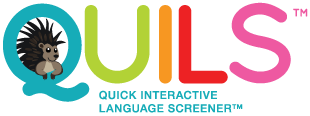Identifying young children with language delays can improve later outcomes
Language is a core ability that children must master for success both in and out of the classroom. Extensive studies have shown that many tasks, including math, depend on linguistic skill, and that early language skills are predictive of school readiness and academic success. Being able to quickly identify children at early ages with language delays is crucial for targeting effective interventions.
Enter the QUILS.

In 2011, the National Center for Education Research (NCER) at IES funded a 4-year grant to Dr. Roberta Golinkoff (University of Delaware) and Drs. Kathy Hirsh-Pasek (Temple University) and Jill de Villiers (Smith College) to develop a valid and reliable computer-based language assessment for preschoolers aged 3-5 years old. The resulting product was the Quick Interactive Language Screener (QUILS), a computerized tool to measure vocabulary, syntax, and language acquisition skills. The assessment ultimately measures what a child knows about language and how a child learns, and automatically provides results and reports to the teacher.
The preschool version of QUILS is now being used by early childhood educators, administrators, reading specialists, speech-language pathologists, and other early childhood professionals working with young children to identify language delays. The QUILS is also being utilized in other learning domains. For example, a new study relied on the QUILS, among other measures, to examine links between approaches to learning and science readiness in over 300 Head Start students aged 3 to 5 years.

QUILS is now being revised for use with toddlers. In 2016, the National Center for Special Education Research (NCSER) funded a 3-year study to revise the QUILS for use with children aged 24-36 months. The researchers have been testing the tool in both laboratory and natural (child care centers, homes, and Early Head Start programs) settings to determine which assessment items to use in the toddler version of QUILS. Ultimately, these researchers aim to develop a valid and reliable assessment to identify children with language delays so that appropriate interventions can begin early.
By Amanda M. Dettmer, AAAS Science & Technology Policy Fellow Sponsored by the American Psychological Association Executive Branch Science Fellowship
Human interaction in society depends upon language and communication and the Institute of Education Sciences is one of several federal agencies that supports research and development (R&D) activities to further our knowledge in this area.

However, so far, there has been no systematic accounting or description of the range of language and communication R & D that the Federal Government supports.To address this gap, the White House Office of Science and Technology Policy’s National Science and Technology Council (NSTC) convened the Federal Government’s Interagency Working Group on Language and Communication. Led by co-chairs from the Department of Education and the Department of Defense, representatives from 13 different federal agencies developed a report of current and recent federal investments in language and communication R & D activities.
This investment is discussed across four broad areas:
- Knowledge and Processes Underlying Language and Communication;
- Language and Communication Abilities and Skills;
- Using Language and Communication; and
- Language and Communication Technologies.
In addition, the report describes the types of current R & D activities in these areas, and provides programmatic recommendations for key areas of investment and collaboration in language and communication research going forward.
On behalf of the working group, IES is gathering information from a wide community interested in language and communication R & D through a recently released request for information (RFI). The purpose of this RFI is to assist the working group in its efforts to further improve coordination and collaboration of R & D agendas related to language and communication across the Federal Government. If you are interested in submitting a response to the RFI, please do so by the deadline of December 30, 2016.
Written by Elizabeth Albro, Associate Commissioner of Teaching and Learning, National Center for Education Research
By Karen Douglas, NCER Program Officer
Improving students’ capacity to understand what they read in all subject areas is a primary focus of educators and policymakers. Educators and researchers have been focused on interventions to improve reading for decades, and a great deal of attention has been given to improving word level skills (such as phonemic awareness and decoding). In part, this focus can be traced to the ‘Simple View of Reading,’ a theoretical framework developed by Gough and Tunmer almost 30 years ago.
The Simple View states that readers need to both understand language and decode the symbols on the page in order to comprehend written text. The influential role of decoding on reading outcomes has been well studied, and many interventions have been developed that show good results in improving these skills for many students. But improvement in decoding skills, while necessary, has not generally been sufficient to improve reading comprehension.

In recent years, researchers have begun exploring the other part of the equation -- language. Most often, researchers use vocabulary knowledge as a proxy for language skills and a great deal of research is focused on improving vocabulary skills. Efforts to improve vocabulary generally show that students learn the new words they are taught, but generalized effects on vocabulary knowledge and reading comprehension are elusive. It seems likely that in addition to understanding the meanings of individual words, students also need to know how words are constructed (morphology), how they are used in text (syntax and grammar), and how to make inferences from text in order to make sense of the wide variety of materials they must read.
The Reading for Understanding Research Initiative (RfU), funded in 2010 by IES, is addressing a broader conception of language in trying to improve reading comprehension. RfU provided funding for six research teams to study the basic processes that undergird reading comprehension, develop and test new curricula and instructional programs to improve it, and develop new assessments to provide a better measure of students’ capacity to read in authentic scenarios. Collectively, RfU researchers are studying the development of reading for understanding from prekindergarten through high school with the goal of creating new knowledge about what matters at each developmental stage in order for students to finish high school with sufficient reading skills for college and career. Each of these six teams has incorporated attention to aspects of language beyond vocabulary knowledge and several teams have published results that provide evidence of the potential of improved language skills for building reading comprehension. Abstracts for studies and publications to date can be found on the IES website.
In a recent article in Educational Psychology Review, my co-author Elizabeth Albro and I describe the purpose of the RfU Research Initiative, the goals of the six teams funded under the initiative, and progress made through 2014. As the work of the RfU Research Initiative comes to completion, the RfU researchers are positioned to make important contributions to what we know about the development of reading for understanding and how we can best improve it for all students. Expanded knowledge about the language skills that support reading for understanding and how to improve them will be a key component of this contribution. Stay tuned to Inside IES Research to learn more about what the teams are finding.